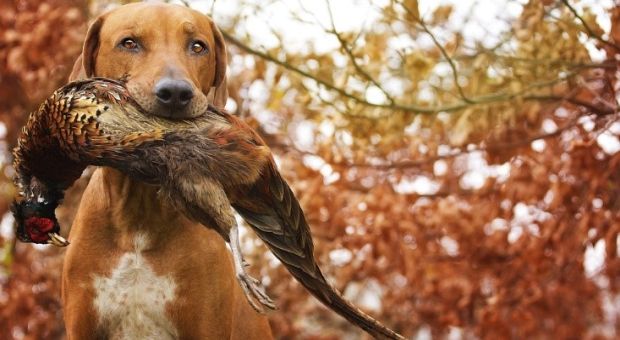Dogs are excellent hunting companions.
They provide assistance in hunting, protect their owners in the wild and can also retrieve small birds and animals. It’s no different for bird dogs. This may seem normal, but it isn’t as easy as it sounds. Bird dogs require regular training from a very young age to become truly skilled at their jobs.
Having a bird dog around will make your hunting a lot more efficient, fast and less tiresome. It will also ensure that you actually get to bring home most of the game that you shoot.
If you’re looking for tips on how to train your bird dog, you’ve come to the right place. Keep reading to find out all the techniques and rules you should follow.
The Right Dog Breed
There are quite a number of breeds that are appropriate for bird hunting. Different bird dogs can be suited for different terrains like uplands and wetlands.
It is extremely important to have the right kind of dog when going bird hunting. This is because some breeds have hunting in their genes. No amount of training for an ordinary dog will make them as good as these hunting dogs.
A few of the best hunting bird dog breeds are:
- Labrador Retrievers
- Golden Retrievers
- English Pointers
- Brittany
- Boykin Spaniel
- Vizsla
- English Setter
Each breed is different and will require specific diets and exercise regimes. Since the dogs mentioned in the list are typically larger dog breeds, these puppies will need to be fed large dog breed food and will need more exercise than other breeds.
Teach Your Bird Dog to be Obedient
To train your dog to hunt, it has to be well versed in the basic commands first. So, make sure your dog knows the common “Come”, “Sit” and “Heel” commands by heart.
Having a proper obedience foundation will make training your hunting dog much easier. Without mastering basic obedience training, it’s unwise to move forward to advanced training.
Force Breaking Your Bird Dog
To teach your dog to hunt, you need to teach it how to force fetch. Basically, your dog should be able to bring back the birds to you.
This activity is termed as ‘force breaking’ and is not as simple as playing fetch.
Force fetch training will teach your dog to hold onto the bird and deliver it to your hand, instead of dropping it on the floor.
First of all, start by table training your dog. This will help with controlling your puppy and helping it maintain stability. After this, you can move on to ground training.
Table Training Rules
After a certain level of comfort with the table is reached, you can teach your dog how to hold and fetch on top of the table.
The best way to do this is by applying pressure to your dog in some way. While you say ‘hold’ or ‘fetch’, pinch your dog and let go when your dog completes the task.
Don’t worry, this will not harm your dog in any way. It will just provide momentary discomfort, which will make your dog remember its task better.
After the whole task, make sure to praise your dog and give it treats as a reward. Positive reinforcement with the pressure technique will work the best.
Now that your dog is familiar with fetching and holding in one place, you can make it walk on the table and fetch objects. The same pressure and positive reinforcement technique should be used here as well.
Ground Training Rules
Once you’re satisfied with the table training, you should try and make your dog do the same activities on the ground. This is not as easy as it seems, the ground might be a confusing terrain for your dog.
You might need to recall the previous commands, using pressure and positive reinforcement again.
Begin again by teaching your dog to fetch and hold while sitting in one place. After it gets a hang of it, start teaching your dog to do the same thing while walking on the ground.
Another training trick is to fill your yard with lots of toys and walk around them with your dog. Only when you give the command should your dog be fetching and retrieving the object.
This will teach your dog to wait and fetch things only when you say ‘fetch’.
Collar-Conditioning a Bird Dog
This is similar to the pressure technique, but the ear pinch is replaced by a collar that gives your dog a mild shock. Again, this does not harm your dog. It only startles your dog enough to remember what it should be doing.
This is convenient to use when you are at a distance, teaching your dog to walk and fetch things.
However, your dog needs to know that this shock is coming from you, just as it was aware you were giving it the ear pinch. The first time you use the collar, place the remote near your dog’s ear and press the button as soon as you say ‘fetch’.
When your dog gets used to this collar, training will be much easier in larger spaces. It’s also efficient in reinforcing the commands that your dog has already learned with the pressure technique.
Teaching Your Bird Dog How to Mark Retrieve
Once force fetch training is done, it’s time to teach your dog the act of mark retrieving.
Your dog has to wait beside you on a leash in a stable state and wait for a mark, or in this case, a bird, to fall. After the mark drops, let your dog go so it can bring back the mark.
Your dog should come back to stand beside you, still holding onto the mark in its mouth. It needs to wait in this position until you take the mark away.
This is an advanced form of training which needs to be done at home as well as in a practical field experience. It is important that your dog learns how to retrieve actual birds, as pretend marks and birds are not the same.
Mark Retrieval for Dogs in Water
Make sure your dog can swim in open lakes before actually going into the field.
When swimming, your dog won’t always be able to see the bumper. However, it’s important for it to keep following the target, even when it is not visible.
Don’t send them in the water if your dog can’t swim. Most people think that dogs are natural swimmers, this statement is not true.
Getting Your Dog Used to Gunfire
Dogs are naturally going to be afraid of gunshots, so it’s important to let them get used to the sound. Start off by testing out how your dog reacts to lower ‘pop’ sounds from a distance.
Training for mark retrieving and conditioning to gunfire should go hand in hand.
Extra Training Advice
Make sure you have a good place to train your puppy. This can be a field, yard or even a park. Your dog should be skilled at running in front before it can hunt. So, keep practicing front-running daily in open spaces.
The easiest way to train your dog is to join a hunt or training club where you can just buy birds. It will let your dog train in different conditions and have the appropriate professional training facilities.
If there is no such club available, find a place where your dog will have access to birds. The best practice bird option for training will be a pigeon as they are cheap and easily available. They also smell a lot like game birds.
Final Thoughts
If you truly want your bird dog to perform well, you have to give it proper training, in all sorts of realistic situations.
Even then, your dog won’t be perfect on the field the first time. It will take years of hunting experience for your dog master retrieving marks.
The key is to remain patient and be consistent with training. Also, remember that positive reinforcement is as equally important as shock or pressure training.
Training should never be too long or rigorous. You need your dog to trust you and enjoy what it is doing in order to reach its full potential.





































































